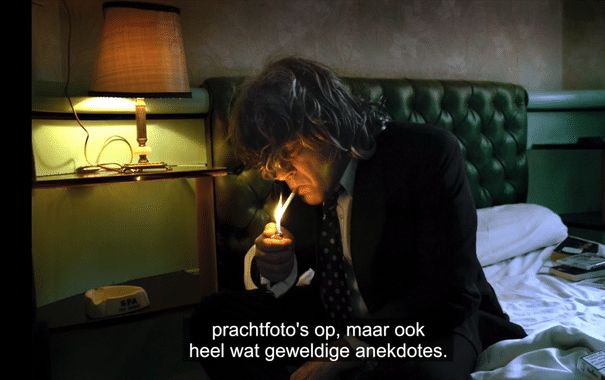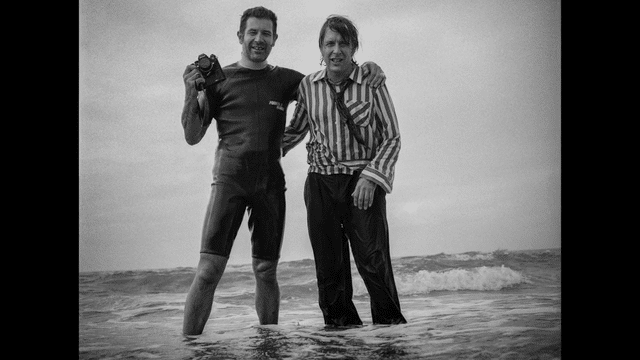Eyefi kindly sent me a Mobi Pro 32 GB wireless SD card to review. The timing was right, because I had been looking for a way to create a tethered workflow in which I can send images I take with my Fujifilm cameras to Lightroom. Although Fujifilm have announced a tethering solution, it is not yet available and once it will be, it will still require you to use a cable.
What is it?
The Eyefi Mobi Pro 32 GB wireless SD card is, as its name implies, a 32 GB SD card that includes a wireless transmitter so you can send your photos wirelessly to your smartphone, tablet or computer. It's priced at about $99 / €89. Eyefi also has a cheaper wireless card, the Eyefi Mobi, that exists in 8 and 16 GB versions. The difference between both is that the Pro version can...
- also transfer raw files
- has an option to only transfer selected photos (the regular Mobi transfers all photos)
- use its own wifi network but also be integrated in your existing home or office network
Note that these options are off by default, but you can enable them by putting your card in your desktop computer's card reader and going into the Eyefi Desktop App's preferences. More about that later.
Working with mobile devices
The Mobi Pro not only allows you to transfer raw files to your computer, you can also send images (JPEG only, if I'm correct) to a mobile device. You only have to install the Eyefi Mobi app, enter the card's serial number in the app and connect your mobile device to the wifi network that the card emits. It was really nice to see the images that I was shooting with my wifi-less X-Pro 1 appearing on my iPhone.
My X-Pro 1 now has wifi capabilities, thanks to the Eyefi Mobi Pro!
So, if nothing else, this card enables you to transfer images that you shoot with a non-wifi equipped camera to a tablet or phone, from which you could then share them to Instagram, Facebook or edit them in an App such as Snapseed. Heck, if you're a Lightroom CC user, you could even have them automatically imported in Lightroom mobile and that way have them wind up in your desktop version of Lightroom, too. Lots of possibilities there!
The Mobi Pro turns (almost) any non-wifi equipped camera into a camera that lets you share images to your mobile devices
On your mobile device, select the Eyefi Mobi Card's network and you're good to go!
By default, the card sends out its own ad hoc wifi signal, so you can even do this in the middle of nowhere: you just have to select the card's wifi network in your phone's wifi settings and you're good to go. As mentioned, by default it sends all the images over but you can configure it (computer required) to only transfer those that you mark on your camera as locked or protected. On the X-Pro 1, when in playback mode, press the OK key and choose the 5th option from the Playback menu: Protect.
So far, so good. I was starting to think it would be nice to use this setup during workshops: I do a lot of teaching and it would be fun to have the images appear on an iPad that I could then pass around to the students. It sure beats looking at a camera LCD or viewfinder (especially the X-Pro 1's EVF)!
The (jpg) images transfer nicely and relatively quickly to the Eyefi Mobi App
However, that's where things didn't quite go as hoped: each time the camera went to sleep, I had to reestablish the wifi connection. So I set the camera to not go to sleep, but then the card's internal settings wrecked havoc: apparently, to conserve power on the camera, the card will shut down the connection after 1 to 2 minutes of non-use. Which is too soon for a real world tethering workflow. I've looked around but there seems to be no easy fix to this. According to Eyefi Customer Care, this cannot be changed. Which is a bummer, because it makes the card unusable for the teaching use I had in mind. Mind you that this auto-disconnect issue does not seem to happen when you shoot to a laptop or desktop computer.
Eyefi Cloud
The Eyefi Mobi Pro also comes with a complimentary free year of Eyefi Cloud: this service lets you upload an (unlimited) amount of images to the Eyefi servers, from where you can also share them or you can use this service as a cloud backup (you can even upload old photos so the service isn't limited to photos you took with an Eyefi card). Eyefi Cloud lets you display your images in a timeline no matter which device you used to take them with. The pictures are shared across all your devices and available for viewing even when there's no internet connection. Of course, you can also share pictures with other people.
Although the concept sounds nice enough, I personally won't be using this service as I already have a full computer backup through backblaze.com and I use Lightroom mobile to display and sync my images online across different devices.
Tethering to a desktop or laptop computer
Being able to transfer images to a phone or tablet is nice, but the main reason I was interested in this card was to wirelessly transfer my raw files to a watched folder on my computer, and have Lightroom pick them up from there using the Lightroom's Auto Import feature. This way, I was hoping not only to shoot tethered into Lightroom, but to do so wirelessly!
The first time you use your card, you have to enter the activation code and then take a couple of test shots. Once your card is recognised, you're good to go. This setup procedure only has to be done once. Make sure to save the card with the activation code in case you change computers or want to use the card with a different computer, too.
I installed the Mobi Pro Desktop App (make sure you have the latest version of that specific app - the version that works with the regular Eyefi Mobi card will not support the extra features of the Mobi Pro card) and set the card up to transfer raw files, too. You have to insert the card in your computer to make that change. A nice touch for raw + jpeg shooters is that you can send both file types to different folders if you want.
The Pro card offers the ability to add up to 32 Home Networks, transfer raw files and enable selective transfer of files.
Again, so far, so good. Just like with the iPhone, after the initial setup procedure is over, you select the card's wifi signal in your computer's list of available networks and you're good to go. However, then came the disappointment: it took about 30 seconds to download a 30 megabyte raw from the X-Pro 1. On top of that, sometimes, the desktop app would not immediately start to download after I made a shot. So I would shoot again and then both shots would be downloaded from the card together. Oddly enough, the second shot would sometimes arrive on my computer before the first, making it hard to judge my shoot's progress. I checked this with Eyefi's (excellent and quick) customer support and they said the maximum speed of the card, using the card's own network, is between 10 to 15 megabit per second, which means that theoretically, that raw file could download in about 15 seconds. But even that is quite long a wait in the heat of a shoot. Eyefi also recommends to keep the card close to the receiving device when transferring. If you're using a megapixel monster like the D800 then those times would easily double.
One of the other exclusive features of the Pro version of the card is that it can also work via your own WIFI network: in fact, you can store up to 32 different networks in the card and it will then default to any of those if it finds one and otherwise it will fall back to creating its own ad-hoc network. This has two advantages: it keeps you from having to switch back and forth between your own network and the card's network and you can use your computer for things such as internet browsing while using the card. I had hoped that the transfer speed might improve, too but I was unable to confirm that. In fact, when I tried the card over my own wifi network, transfer speed was slower than through the card's own ad hoc network. Working via my own network did give me one (important) advantage: even if I put the camera down for a while, I could just pick it up again and start shooting and the files would automatically transfer again. When using the Eyefi's ad hoc (own) wifi signal, just as with my iPhone, the network connection dropped after a minute or two. It's really a pity though that we cannot configure this timing. I would be interested to hear other user's experience with this.
Back to jpgs, then?
So I decided to try how fast a jpg would transfer. FINE jpgs from an X-Pro 1 are about 3 megabyte and those downloaded in 3 seconds. A burst of 10 shots downloaded in half a minute. Unless you're shooting very fast, I consider that workable. So at least, when I'm in a situation where I can use another network than the card's own (because of the reason explained at the end of the previous paragraph), I seem to be able to tether jpg files to the computer steadily enough.
Conclusion
Unless you're a very slow and deliberate shooter, raw tethered shooting in a professional environment is possible in theory, but not in practice, IMHO. Does that mean I won't be using the Mobi Pro? No, on the contrary: I find it to be a valuable tool, as long as you set your expectations right, which was the point of this blog post.
First of all, I like the fact that I can transfer selected shots from my X-Pro 1 to my iPad or iPhone for social sharing or quick editing. And as far as tethered shooting to a computer goes: whenever there's a shoot where I feel I can benefit from shooting wirelessly straight into Lightroom, I will shoot raw + jpg on the card but transfer only the jpg files wirelessly and import those into Lightroom. I will do my ratings, flags and possibly some minor editing on those jpg images. After the shoot, when the client or the model have gone home, I will copy the raw files over the old-fashioned way: by putting the card into my computer!
And before you pity me for having to manually copy over my edits from the jpg to the raw files or even worse, doing everything over again, don't: I've got a trick up my sleeve that I will share in next week's blog post. Stay tuned!
UPDATE: 'next week's blog post' is now live, here! In this blog post, I'll show you how to automatically import your images into Lightroom and how to transfer any edits you've already performed on the JPGs to your raw files.
Cons
- wireless raw transfer too slow for tethered shooting use in studio or outside, using jpg is recommended
- auto-disconnects too quickly when used with iPhone / iPad for tethered use with these devices
Pros
- turns cameras without wifi into wifi-enabled cameras
- works with Mac and Windows, iOS and Android
- wireless transfer of raw files, ok for one-offs
- option to transfer only selected files
- if configured, works with your own network
- fast customer support














